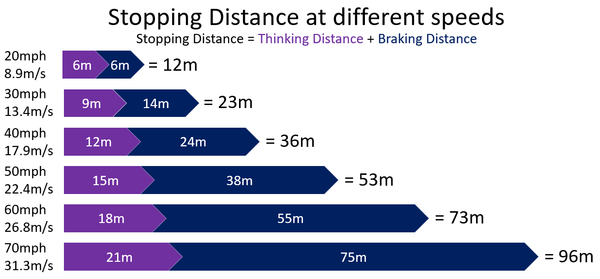Difference between revisions of "Stopping Distance"
| Line 14: | Line 14: | ||
*The [[Human Reaction Time|reaction time]] of the driver - The longer the [[Human Reaction Time|reaction time]] the longer the [[Thinking distance|thinking distance]] and therefore '''stopping distance'''. | *The [[Human Reaction Time|reaction time]] of the driver - The longer the [[Human Reaction Time|reaction time]] the longer the [[Thinking distance|thinking distance]] and therefore '''stopping distance'''. | ||
*The conditions of the road and tyres - The less [[friction]] between the road and tyres the longer the [[Braking Distance|braking distance]] and therefore '''stopping distance'''. | *The conditions of the road and tyres - The less [[friction]] between the road and tyres the longer the [[Braking Distance|braking distance]] and therefore '''stopping distance'''. | ||
| + | |||
| + | {| class="wikitable" | ||
| + | |- | ||
| + | |[[File:StoppingDistances.png|center|600px]] | ||
| + | |} | ||
Revision as of 10:55, 17 February 2019
Key Stage 4
Meaning
Stopping distance is the distance a vehicle travels between the driver noticing a hazard and coming to a stop.
About Stopping Distance
Stopping distance is made of two parts:
- Thinking Distance - The distance travelled by the vehicle between noticing a hazard and putting the foot on the brakes.
- Braking Distance - The distance travelled once the vehicle has applied the brakes.
Stopping Distance = Thinking Distance + Braking Distance
Stopping distance depends on:
- The speed of the vehicle - The greater the speed the larger the stopping distance.
- The reaction time of the driver - The longer the reaction time the longer the thinking distance and therefore stopping distance.
- The conditions of the road and tyres - The less friction between the road and tyres the longer the braking distance and therefore stopping distance.
